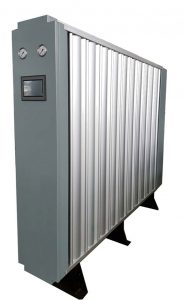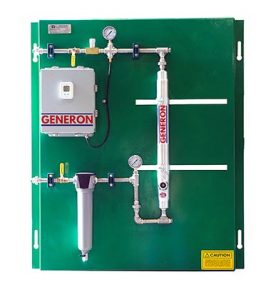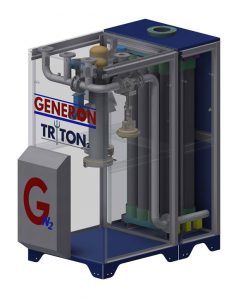What Is Nitrogen Purging? How Does It Work and What Equipment Is Required?
August 21, 2018
Nitrogen has many applications and depending on the industry, it can be used for a wide variety of tasks and objectives. A colorless and odorless gas, this element makes up around 78 percent of our atmosphere.
Although commonly associated with our atmosphere, industrially produced nitrogen is used in several applications. From the beer brewing industry to the petrochemical industry, nitrogen purging allows for a more productive, safe environment.

If any of your systems require regular purging, here’s what you need to know about the various methods and processes.
What Is Nitrogen Purging?
This industry standard technique is the act of displacing any undesirable or hazardous atmosphere with an inert nitrogen atmosphere. If you work in an industry where the contamination of hazardous gases is possible, then nitrogen purging is an absolute necessity.
Why Is Nitrogen Used for Purging?
Nitrogen is dry and non-combustible, and the nitrogen displacement of combustible gases will prevent an unstable and potentially ignitable atmosphere. Simply put, the use of nitrogen in oil and gas industry equipment effectively displaces moisture and oxygen and creates a more stable climate.
The Different Types of Nitrogen Purging Systems
When it comes to nitrogen purging, there are varying systems and methods involved — all of which require different equipment. Easily adapted, the method of nitrogen purging will depend on the equipment used (i.e., the shape and type), as well as the location of the purging outlets and inlets.
The four core methods of nitrogen purging include:
1. Pressure transfer of liquids
In certain cases, you may want to transfer liquids without using a pump. To complete this task, nitrogen will allow you to pressurize the headspace within a vessel. This is the method most often used when there are space constraints or if there are certain materials that impact pump efficiency.
By utilizing this method of purging, you will be able to significantly reduce the risk of oxidation — which often occurs while transferring liquid from one tank to another.
2. The pressure-hold vacuum method
When conditions do not allow a “sweeping action” of nitrogen, a vessel can be pressurized using nitrogen. Once the contents of the vessel are combined with nitrogen, dilution occurs. This combination is then vented, and the process is repeated.
This method is ideal when a vessel only has one opening. The amount of nitrogen required in this case will depend on the number of pressurized purges required to reduce the contaminant until it reaches an acceptable level.
3. Displacement purging
When equipment has straightforward cross-sections, such as those found in pipelines, this method is ideal. In most cases, a scraping piston, known as a “pig” — is propelled by the pressure of nitrogen. As the pig pushes through the line, it effectively purges the contents.
In this case, the amount of nitrogen required is based on the volume of the pipe. Unlike the other methods, such as dilution purging, you can purge a system without appreciable mixing. Although mechanical pig launchers and receivers are most often used, you can also separate nitrogen and another substance with an inert fluid.

4. Dilution purging
This option is ideal for complex systems and equipment cross sections which include kilns, columns, reactors, etc. By mixing nitrogen with the gas you need to purge, contents can then be effectively purged through an outlet point — which should be as far away from the inlet point as possible.
When considering this method, the most important consideration is the location of both the entry and exit points. By diluting and displacing the contents in question, this method results in a more inert environment.
How Does the Nitrogen Purging Procedure Work?
The goal of any nitrogen purging system is to “cleanse” pipes and other parts that contain contaminants. In doing so, you will significantly reduce any risk associated with hazardous elements, including oxygen. Depending on the method used, nitrogen may circulate at either high or low pressures.
Of course, the specific nitrogen displacement procedure used will depend on many factors, including some of the points we discussed above. Regardless of the method used, you will need access to a steady flow of nitrogen.
This is where a nitrogen generator comes into play, helping you achieve up to 99.9 percent purity levels. To learn more about the production of nitrogen gas, please refer to our PSA nitrogen generator systems and membrane nitrogen generators.
Oilfield nitrogen services that rely on delivery of nitrogen vessels can be expensive and dangerous. Onsite nitrogen generation systems will allow you to gain instant access to on-site nitrogen, creating a more cost-effective, reliable, and safe solution. Although an up-front investment is required, the daily savings are immense. These savings are seen across all industries based on less gas waste and increased productivity as less time is wasted due to delivery and wait times).
At Generon, we offer custom nitrogen systems, a wide range of parts, and a variety of services. If you would like to discuss your nitrogen generation needs or the process of nitrogen purging, please contact us today — we’re happy to help!
GENERON Products for Nitrogen Purging
GENERON offers a number of nitrogen system solutions for many industries with a variety of applications and specifications. Check out the popular Nitrogen Purging products below or simply contact us today for more information.
 |
 |
 |
Compact Bank PSA Nitrogen Generators |
Nitrogen On Wall (NOW) Panel |
Nitrogen Generator Cabinets |
